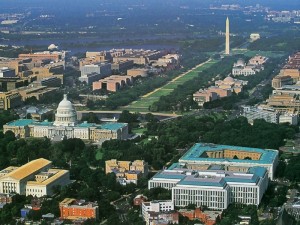Congress Makes History
This is a big deal … Congress has cut spending two consecutive years
I recently attended a political event where a Republican congressman was making a re-election pitch. It was the usual stump speech. But one thing he said especially struck me. “This Congress has cut spending—yes, actually cut spending—each of the last two years,” he asserted. “And how rare is that?”
Well, it would be extremely rare. So rare, in fact, that I frankly didn’t believe the man. I made a mental note to check the data when I got home.
I delayed doing that. My incredulity got the best of me. Surely, the congressman was exaggerating. It’s the political season, after all. I moved on.
That was several weeks ago. Then, however, came a moment that prompted me to follow up. As a professor who teaches Comparative Politics every fall semester, I was at the spot in my course where I review the tax-and-spending patterns of the U.S. federal government. Each time, I show students the one constant in the political universe: Our federal government never cuts spending. It simply doesn’t happen. I stroll into class with data from OMB (Office of Management and Budget) and CBO (Congressional Budget Office) illustrating just that.
This data is simple to access. It’s as easy as Googling “historical tables deficit.” Two sources pop up: OMB historical tables and CBO historical tables. They are the go-to sources for data on deficits, debt, revenue, and government expenditures. To keep things simple here, I’ll cite OMB data, which is published in an easily readable link titled, “Summary of Receipts, Outlays, and Surpluses or Deficits: 1789-2016.” This table provides the official record of federal spending since the founding of the republic.
Digging into that data, a pattern quickly strikes the reader: Once upon a time in America, expenditures and revenue both moved up and down. Congress was capable of cutting spending in years when revenue declined—the sort of thing you do in your home or business. Then came a watershed year when such common sense vanished, supplanted by a form of fiscal irresponsibility and suicide. Beginning in 1965, the start of LBJ’s Great Society, something historically deviant commenced: Spending increased every single year, non-stop, consistently, with total disregard for revenue. This meant chronic deficits and debt.
Starting in 1965, there was an unceasing upward trajectory in federal spending. Notably, revenue did not do the same. During recessions and economic downturns, tax revenue dips. There were seven occasions between 1965 and the start of the Obama administration that witnessed annual revenue declines—but never spending declines.
The responsible thing for Congress would have been to cut spending during those declines in revenue. That, however, didn’t happen. Politics being what it is, the spending continued its steady annual rise, as did our national debt.
At the start of the Great Society, revenue and expenditures were nearly equal, with expenditures only slightly higher, leaving a manageable deficit of $1.4 billion. By 2009, however, annual expenditures ($3.5 trillion) had far outpaced annual revenue ($2.1 trillion), leaving a record deficit of $1.4-plus trillion.
Significantly, the biggest one-year drop in revenue was from 2008-9, when it declined from $2.5 trillion to $2.1 trillion. But rather than cut spending, the government exploded it. President Obama and the Democratic Congress responded with an $800-billion “stimulus” package in 2009 (i.e., more spending). That further mushroomed the record deficits/debt we faced. It was fiscally disastrous. We went from a record 2008 deficit of $458 billion to a record 2009 deficit of $1.41 trillion.
And so, I showed my students, that’s the lesson: The federal government does not cut spending, regardless of how much money it has.
That is, until now—which brings me back to that congressman. I finally checked on his claims. I was shocked. He was correct: Congress cut spending from 2011-13. It was reduced from $3.60 trillion in 2011 to $3.53 trillion in 2012 to $3.45 trillion in 2013. The reductions are far from earthshattering, but, for the federal government, this is pretty much an earthquake.
This is the first time since 1953-55 that spending was cut in consecutive years—in literally over a half century.
Wow. I honestly didn’t think I’d ever live to see it. I’m 47 years old, and this is the first time in my lifetime that a Congress has consecutively cut spending. For years, I’ve lectured, commented, and written about how Washington literally does not cut spending. I need to amend that. History has been made.
And yet, Congress doesn’t seem to be getting much credit for this. Sure, the Republicans will hold Congress. But when I listen to conservative talk-radio or talk to Republicans or read conservative websites, they constantly bash their own Republican Congress as feckless, useless, as no better than President Obama and the Democrats. They eviscerate John Boehner as a wimp and a stooge. They demand that “Reagan conservatives” be elected to Congress. Well, I have news for them: Ronald Reagan never saw a reduction in federal spending—not once in eight years. Neither did George W. Bush. For that matter, neither has any modern Democrat. Even the Clinton-Gingrich partnership, which eliminated the deficit, never actually cut spending in any year throughout the 1990s (though the rate of growth of spending was cut, which helped reduce the deficit). Only the current Congress has done that. I’m really surprised.
Alas, there’s even more good news in this. This means that the record deficit that threatened to bury this nation four years ago, on the heels of the Pelosi Congress, has been cut by more than half. It has been reduced dramatically, from $1.4 trillion in 2009 to $500 billion in 2014. That’s still high, but it’s a remarkable improvement.
If you want the answer for how that happened, it’s simple: your Congress has finally managed to cut spending. That is a big deal.
[Editor’s note: a version of this article first appeared in USA Today.]


